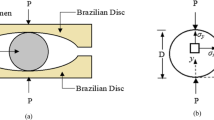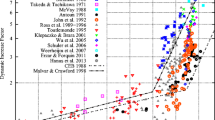Abstract
The tensile strength of concrete-like materials varies wiries when different test procedures or even different shapes and sizes of specimens are employed. Correlations have previously been established but restricted to particular test conditions.
The approach here presented, based on the “weakest link of the chain” concepts, offers the possibility of correlating the results of the different tensile tests of concrete-like materials. For that purpose, the amount of material under a tensile stress greater than 0.95 of the maximum tensile stress in the specimen must be evaluated. Relating the maximum tensile stress at the moment of failure with the above mentioned volume (Highly Stressed Volume), a decreasing function is obtained. The function fitted can be used to obtain a tensile strength value of the material, free from the influence of the characteristics of tests and specimens.
In this experimental work, the function is established by testing seven different mortar mixes, subjected to nine different test conditions. Centered-point and third-point loading flexural tests and splitting tests were carried out on specimens of different sizes. Direct tension on a briquertte was also applied.
The test results showed a decreasing linear regression between the logarithm of the maximum tensile stress at the moment of failure and the logarithm of the highly stressed volume. The slope of that line remained fairly constant for the seven mortar mixes tested.
Résumé
Au cours de cette étude on a établi une relation générale entre les différentes résistances en traction des matériaux du type béton qui est basée sur le concept de «weakest link».
On a essayé sept mélanges de mortiers dans neuf conditions différentes d'essai de traction: essais de flexion avec charge centrée et charge au tiers central, essai de traction par fendage sur des éprouvettes de différentes dimensions et essais de traction directe. Dans chaque cas, on a évalué le volume de matériau sous une contrainte de traction supérieure à 0,95 de la traction maximale de l'éprouvette (volume de plus grande contrainte).
On a obtenu une relation linéaire décroissante entre le logarithme de la contrainte de traction à la rupture et le logarithme du volume de plus grande contrainte, avec une pente qu'on peut considérer comme constante pour les sept mélanges essayés.
Similar content being viewed by others
References
Malhotra V. M., Zoldners N. G.—Comparison of ring-tensile strength of concrete with compressive, flexural and splitting-tensile strengths, Journal of Materials, Vol. 2, No. 1, March 1967, pp. 160–199.
Ramakrishnan V., Ananthanarayana Y., Gopal K. C. —The determination of the tensile strength of concrete: a comparison of different methods, Indian Concrete Journal, Vol. 41, No. 5, May 1967, pp. 202–206.
Ward M. A., Newman K.—Behaviour of plain concrete subjected to uniaxial tension and compression. II. Interamerican Conf. Mat. Technol., Mexico City, August 1970, pt. 1, pp. 9–22.
Pineiro M., Vasquez R., Vergara A.—Tension strength of concrete. Comparison between direct tensile, splitting and flexure strength. II. International Conf. Mat. Technol., Mexico City, August 1970, pt. 1, pp. 24–42.
Popovics S.—Meaning and determination of flexural and tensile strengths of concrete. II. Interamerican Conf. Mat. Technol., Mexico City, August 1970, pt. 1, pp. 43–54.
Spetla Z., Kadlecek V.—Effect of the slenderness on the direct tensile strength of concrete cylinders and prisms. RILEM Bulletin, No. 33, December 1966, new series, pp. 403–412.
Kadlecek V., Spetla Z.—Effect of size and shape of test specimens on the direct tensile strength of concrete. RILEM Bulletin, No. 36, September 1967, new series, pp. 175–184.
Wright P. J. F.—The effect of the method of test on the flexural strength of concrete. Mag. Concr. Res. Vol. 4, No. 11, October 1952, pp. 67–76.
Malhotra V. M.—Effect of specimen size on tensile strength of concrete. Journal of the A.C.I., Vol. 67, No. 6, June 1970, pp. 467–469.
Walker S., Bloem D. L.—Studies of flexural strength of concrete-Part 3: Effects of variations in testing procedures. Proc. A.S.T.M., Vol. 57, 1957, pp. 1122–1142.
Kuguel R.—A relation between theoretical stress concentration factor and fatigue notch factor deduced from the concept of highly stressed volume. Prod. A.S.T.M., Vol. 61, 1961, pp. 732–748.
Kuguel R., Torrent R. J.—On a greater and better use of tests on concrete-like materials specimens (In spanish). III. Interamerican Conf. Mat. Technol., Rio de Janeiro, August 1972, pp. 92–98.
Neville A. M.—Properties of Concrete, London, Pitman Paperbacks, 1970, pp. 401–403.
Crow E. L., Davis F. A., Maxfield M. W.—Statistics Manual. New York, Dover Publications, 1960, pp. 152–158.
Frocht M. M.—Photoelasticity. New York, John Wiley and Sons., Vol. 2, 1957, pp. 125–129.
Desai C. S., Abel J. F.—Introduction to the finite element method. A numerical method for engineering analysis. New York Van Nostrand Reinhold Co., 1972.
Haitz C., Margueirat C., Torrent R. J.—The determination of the distribution of stresses in the French briquette by the finite element method. National Institute of Industrial Technology (I.N.T.I.), Internal report, Buenos Aires, December 1976.
Duriez M., Arrambide J.—Nouveau traité de matériaux de construction. Paris, Dunod, 1961, pt. 1, p. 759.
Coker E. G., Filon L. N.—A treatise on photo-elasticity. Cambridge, University Press, 1957, pp. 578–583.
Author information
Authors and Affiliations
Rights and permissions
About this article
Cite this article
Torrent, R.J. A general relation between tensile strength and specimen geometry for concrete-like materials. Mat. Constr. 10, 187–196 (1977). https://doi.org/10.1007/BF02478688
Issue Date:
DOI: https://doi.org/10.1007/BF02478688




